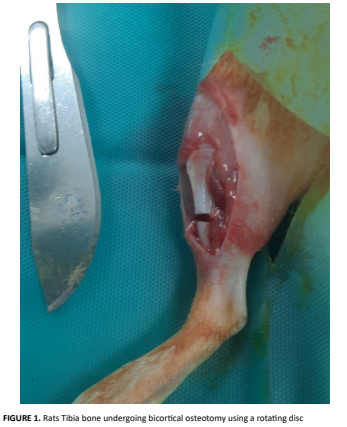Efecto de los anticoagulantes sistémicos en la consolidación de fracturas en la tibia de ratas
Resumen
Este estudio tuvo como objetivo evaluar los efectos de los anticoagulantes sistémicos Apixabán, Rivaroxabán, Edoxabán y Dabigatrán en la consolidación de fracturas. Se conformaron 6 grupos de ratas hembra Spraque Dawley de 8 ejemplares cada uno. Grupo control sano (n=8): no se aplicó ningún procedimiento durante las cuatro semanas de duración del experimento. En el resto de los grupos, se crearon fracturas en las tibias derechas mediante métodos quirúrgicos y se fijaron con agujas de Kirshner. Grupo simulado (n=8): no recibió tratamiento con anticoagulantes. El resto de los grupos recibieron las siguientes dosis de los farmacos correspondientes mediante sonda oral tres veces por semana: grupo apixabán (n=8) recibió 5 mg/ kg; grupo rivaroxabán (n=8) recibió 3 mg/kg; grupo edoxabán (n=8) recibió 3 mg/kg; y el grupo dabigatrán (n=8) recibió 10 mg/kg. Al final del período experimental de cuatro semanas, todas las ratas fueron eutanacia. Se extrajo tejido óseo, se descalcificó y se procesó para análisis histológico. Se observó una diferencia estadísticamente significativa entre los grupos (P < 0,05). El análisis post hoc reveló que el grupo Apixabán (M = 55,75, DE = 3,41) y el grupo Rivaroxabán (M = 55,38, DE= 3,89) tuvieron valores medios significativamente más altos en comparación con el grupo Control (M = 41,75, DE = 5,57) (P < 0,05). Además, el grupo Dabigatrán (M = 44,00, DE = 4,66) y el grupo Edoxabán (M = 48,63, DE = 5,55) también difirieron significativamente del Control, con Edoxabán mostrando una diferencia estadísticamente significativa en comparación con Dabigatrán (P < 0,05). No se observó una diferencia significativa entre Apixabán y Rivaroxabán. Las evaluaciones histopatológicas revelaron que la administración de estos anticoagulantes tuvo efectos estadísticamente significativos en la formación de hueso nuevo en comparación con el grupo control.
Descargas
Citas
Brinker WO, Piermattei DL, Flo GL. Small Animal Orthopedics & Fracture Treatment. 2nd ed. Philadelphia: WB Saunders Company; 1990.
Gartner LP, Hiatt JL. Color textbook of histology, 2nd ed. Philadelphia: WB Saunders Company; 2001.
Vertenten G, Gasthuys F, Cornelissen M, Schacht E, Vlaminck L. Enhancing bone healing and regeneration: present and future perspectives in veterinary orthopaedics. Vet. Comp. Orthop. Traumatol. 2010; 23(3):153-162. doi: https://doi.org/bjthfb DOI: https://doi.org/10.3415/VCOT-09-03-0038
Schmidt-Bleek K, Petersen A, Dienelt A, Schwarz C, Duda GN. Initiation and early control of tissue regeneration - bone healing as a model system for tissue regeneration. Expert Opin. Biol. Ther. [internet]. 2014; 14(2): 247-259. doi: https://doi.org/gsht8b DOI: https://doi.org/10.1517/14712598.2014.857653
Mafamane H, Hackenbroich C, Ellinghaus A, Schmidt- Bleek K. Research in Fracture Healing and Its Clinical Applications in the Veterinary Practice. J. Vet. Sci. Anim. Husb. [Internet]. 2017; 5(3):303. doi: https://doi.org/p8jh
Opal SM. Phylogenetic and functional relationships between coagulation and the innate immune response. Crit. Care Med. [Internet]. 2000; 28(9):S77-80. doi: https://doi.org/bzqhpx DOI: https://doi.org/10.1097/00003246-200009001-00017
Schmidt-Bleek K, Schell H, Schulz N, Hoff P, Perka C, Buttgereit F, Volk HD, Lienau J, Duda GN. Inflammatory phase of bone healing initiates the regenerative healing cascade. Cell Tissue Res. [Internet]. 2012;347(3):567-573. doi: https://doi.org/dd3xbp DOI: https://doi.org/10.1007/s00441-011-1205-7
Bozoglan A, Dundar S, Yildirim TT, Bulmus O, Ertugrul AS, Bozoglan MY, Tekin S, Toy VE. Effects of Different Levels of Restraint Stress on Bone-Implant Contact. J. Craniofacial Surg. [Internet]. 2019; 30(4):1294-1297. doi: https://doi.org/p8jk DOI: https://doi.org/10.1097/SCS.0000000000005104
Weinz C, Schwarz T, Kubitza D, Mueck W, Lang D. Metabolism and excretion of rivaroxaban, an oral, direct factor Xa inhibitor, in rats, dogs, and humans. Drug. Metab. Dispos. [Internet]. 2009; 37(5), 1056-1064. doi: https://doi.org/b3rgvm DOI: https://doi.org/10.1124/dmd.108.025569
Wang L, He K, Maxwell B, Grossman SJ, Tremaine LM, Humphreys WG, Zhang D. Tissue distribution and elimination of [14C] apixaban in rats. Tissue distribution and elimination of [14C] apixaban in rats. Drug Metab. Dispos. [Internet]. 2011; 39(2), 256-264. doi: https://doi.org/bdjszz DOI: https://doi.org/10.1124/dmd.110.036442
Jakowenko N, Nguyen S, Ruegger M, Dinh A, Salazar E, Donahue KR. Apixaban and rivaroxaban anti-Xa level utilization and associated bleeding events within an academic health system. Thromb. Res. [Internet]. 2020; 196:276-282. doi: https://doi.org/gpvt96 DOI: https://doi.org/10.1016/j.thromres.2020.09.002
Wienen W, Stassen JM, Priepke H, Ries UJ, Hauel N. In-vitro profile and ex-vivo anticoagulant activity of the direct thrombin inhibitor dabigatran and its orally active prodrug, dabigatran etexilate. Thromb. haemost. [Internet]. 2007; 98(1):155-162. DOI: https://doi.org/10.1160/TH07-03-0183
Klebe D, Flores JJ, McBride DW, Krafft PR, Rolland WB, Lekic T, Zhang JH. Dabigatran ameliorates post-haemorrhagic hydrocephalus development after germinal matrix haemorrhage in neonatal rat pups. J. Cereb. Blood Flow Metab. 2017; 37(9):3135-3149. doi: https://doi.org/p8jn DOI: https://doi.org/10.1177/0271678X16684355
Bounameaux H, Camm AJ. Edoxaban: an update on the new oral direct factor Xa inhibitor. Drugs. [Internet]. 2014;74(11):1209-1231. Erratum in: Drugs. 2014;74(12):1455. doi: https://doi.org/f6pvdt DOI: https://doi.org/10.1007/s40265-014-0261-1
Poulakos M, Walker JN, Baig U, David T. Edoxaban: A direct oral anticoagulant. Am. J. Health Syst. Pharm. [Internet]. 2017; 74(3):117-129. doi: https://doi.org/f9qbws DOI: https://doi.org/10.2146/ajhp150821
Prodinger PM, Burgkart R, Kreutzer K, Liska F, Pilge H, Schmitt A, Knödler M, Holzapfel BM, Hapfelmeier A, Tischer T, Bissinger O. Does Anticoagulant Medication Alter Fracture-Healing? A Morphological and Biomechanical Evaluation of the Possible Effects of Rivaroxaban and Enoxaparin Using a Rat Closed Fracture Model. PLoS One. [Internet]. 2016; 11(7):e0159669. doi: https://doi.org/p8jq DOI: https://doi.org/10.1371/journal.pone.0159669
Klüter T, Weuster M, Brüggemann S, Menzdorf L, Fitschen- Oestern S, Steubesand N, Acil Y, Pufe T, Varoga D, Seekamp A, Lippross S. Rivaroxaban does not impair fracture healing in a rat femur fracture model: an experimental study. BMC Musculoskelet. Disord. [Internet]. 2015; 16:79. doi: https://doi.org/f68bcv DOI: https://doi.org/10.1186/s12891-015-0502-9
Namba S, Yamaoka-Tojo M, Kakizaki R, Nemoto T, Fujiyoshi K, Hashikata T, Kitasato L, Hashimoto T, Kameda R, Meguro K, Shimohama T, Tojo T, Ako J. Effects on bone metabolism markers and arterial stiffness by switching to rivaroxaban from warfarin in patients with atrial fibrillation. Heart Vessels. [Internet]. 2017; 32(8):977-982. doi: https://doi.org/p8jr DOI: https://doi.org/10.1007/s00380-017-0950-2
Lau WC, Chan EW, Cheung CL, Sing CW, Man KKC, Lip GYH, Siu CW, Lam JKY, Lee ACH, Wong ICK. Association between dabigatran vs warfarin and risk of osteoporotic fractures among patients with nonvalvular atrial fibrillation. JAMA. [Internet]. 2017; 317(11):1151–1158. doi: https://doi.org/f9vkw4 DOI: https://doi.org/10.1001/jama.2017.1363
Norby FL, Bengtson LGS, Lutsey PL, Chen LY, MacLehose RF, Chamberlain AM, Rapson I, Alonso A. Comparative effectiveness of rivaroxaban versus warfarin or dabigatran for the treatment of patients with non-valvular atrial fibrillation. BMC Cardiovasc. Disord. [Internet]. 2017; 17(1):238. doi: https://doi.org/gbxb73 DOI: https://doi.org/10.1186/s12872-017-0672-5
Kyriakaki I, Karanikola T, Lillis T, Kontonasaki E, Dabarakis N. Effect of direct oral anticoagulant dabigatran on early bone healing: An experimental study in rats. J. Adv. Periodontol. Implant Dent. [Internet]. 2023; 15(2):86-92. doi: https://doi.org/p8jt DOI: https://doi.org/10.34172/japid.2023.020
Butler AJ, Eismont FJ. Effects of Anticoagulant Medication on Bone-Healing. JBJS Reviews. [Internet]. 9(5):e20.00194. doi: https://doi.org/p8jv DOI: https://doi.org/10.2106/JBJS.RVW.20.00194
Gómez-Outes A, Terleira-Fernández AI, Suárez-Gea ML, Vargas-Castrillón E. Dabigatran, rivaroxaban, or apixaban versus enoxaparin for thromboprophylaxis after total hip or knee replacement: systematic review, meta-analysis, and indirect treatment comparisons. BMJ. [Internet]. 2012; 344:e3675. doi: https://doi.org/gb3r9b DOI: https://doi.org/10.1136/bmj.e3675
Fusaro M, Dalle Carbonare L, Dusso A, Arcidiacono MV, Valenti MT, Aghi A, Pasho S, Gallieni M. Differential Effects of Dabigatran and Warfarin on Bone Volume and Structure in Rats with Normal Renal Function. PLoS One. [Internet]. 2015; 10(8):e0133847. doi: https://doi.org/f7z2xz DOI: https://doi.org/10.1371/journal.pone.0133847
















